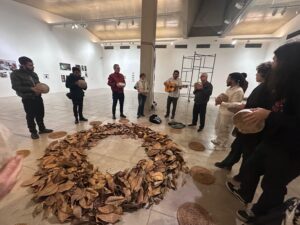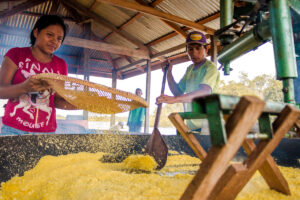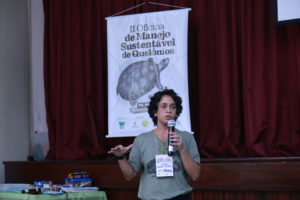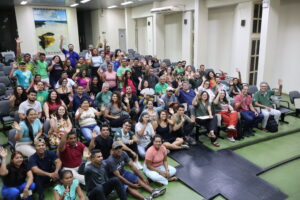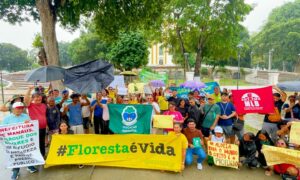By: Nathália Messina
“Nature cries for help!” This is how Manoel, a resident of the São Raimundo community, in Mid-Juruá, portrays the scene of araçarís – birds typical of Amazon rainforest similar to toucans – drinking water from the water tank aerator.
The image synthesizes an alarming scenario: the extreme drought afflicting Amazon in 2024, declared by the state Civil Defense as the worst in history in socioeconomic terms, according to a G1 report. As the intensity and frequency of severe droughts increase, the urgency to discuss the impact of climate change in the region grows, along with the crisis that directly affects the sustainable management of natural resources, such as the pirarucu, one of the pillars of the sociobioeconomy of the Mid-Juruá.
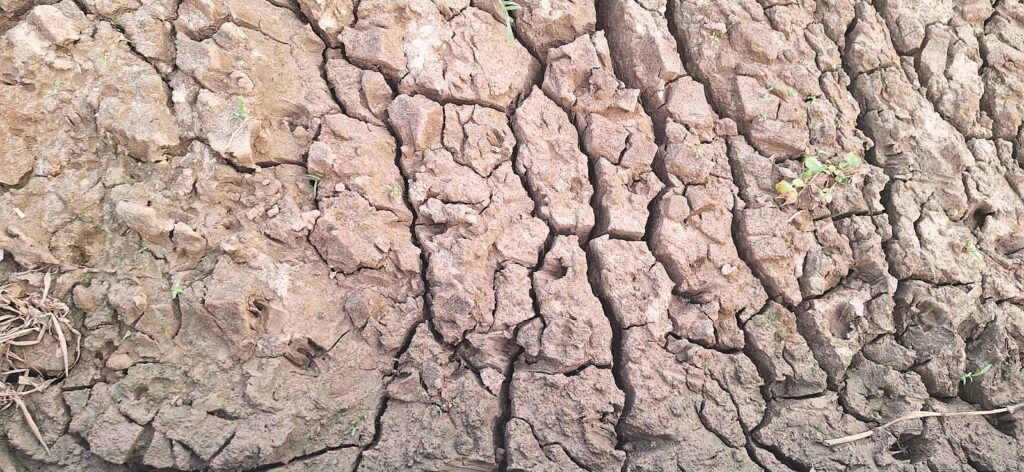
The “new normal” and the socio-biodiversity matter
The year 2024 reaffirms a reality that has long been warned about by specialists and the Amazonian communities: the intensification of extreme climate events. This year’s drought comes in the wake of a recent history of environmental disasters and crises of various kinds in the region. Prolonged droughts, devastating floods, landslides, heatwaves, wildfires and smoke clouds have become an increasingly common phenomenon in the daily life of the northern communities.
In the Mid-Juruá, the study “Climate Change and its Impacts on the Sociobiodiversity of the Juruá River”, developed by João Vitor Campos-Silva and partners1, under the coordination of Sitawi, reveals evident impacts even in a preserved area that encompasses Conservation Units, such as Uacari Sustainable Development Reserve (RDS) and the Mid-Juruá Extractive Reserve (RESEX). “One of the issues frequently present in the discourse of the local population is that daytime temperatures have increased significantly in the last decades. Some even report the feeling that ‘the sun is getting close to the Earth’, as it was previously possible to work all morning, but now no one is able to work after 9 or 10 in the morning,” the report points out. This has a direct impact on the life quality of riverside communities and the work of sociobiodiversity chains.
The shallow depth of the rivers or the lack of water in certain stretches of the Juruá make the areas inaccessible, hampering the transport of products such as the pirarucu, the symbolic fish of sustainable management in the region. The waters that once allowed fluid navigation are no longer sufficient even to pass boats loaded with ice to certain lakes, much less boats loaded with the authorized fishing quotas. Logistics have been severely weakened, especially between September and October, but the hope is that the flood will arrive as a repiquete (gradual rise) by the end of this month, allowing for improved management of the pirarucu, sometimes with a certain degree of normalcy, other times in a limited way.
According to José Gomes, known as Coquinho, Forest Production Technician at ASPROC – the Association of Rural Producers of Carauari: “Today we are using smaller transportation methods with a maximum capacity of 20 tons. These transports are managing to carry the production from the communities to the municipal headquarters with difficulty. The vessels from Carauari to the cold storage facilities – Manaus and Manacapuru – are also having difficulty with transportation, but despite all the challenges, fishing is being carried out with restrictions. In September, fishing was scheduled for the communities with lower catch volumes so that we could use smaller vessels” said the technician from ASPROC; and the same has been happening up to the present moment (October 18th), as the river level has risen very little, he added in an updated conversation.
Beyond the pirarucu, other value chains of sociobiodiversity, such as the collection of oilseed seeds, are also at risk. The forest, known for its richness in non-timber products, has suffered from degradation caused by the loss of hydric resources, which has altered the seasonality and the collection techniques of the seeds.
In the words of Manuel Cunha, manager of the RESEX Mid-Juruá, in response to the community representative of São Raimundo, the impacts are profound: “The forest no longer offers anything. These animals — araçari, toucans — drink water from tree hollows and from parasites; they are animals that do not usually descend to the lake shore to drink. They are seeking help as best they can [from the water tank] because there is no more water in the forest.”
This scenario risks not only animal species but also the survival of traditional communities that depend on natural resources for their economy and ways of life. The extractive population faces daily challenges in maintaining their activities, such as fruit collection, fishing, and pirarucu management, amid an increasingly uncertain climate.
The urgency of concrete actions
In light of this scenario, the need for adaptive and mitigating measures has never been more urgent. The current crisis reinforces the role of sustainable management initiatives, which have been fundamental over the years for the preservation of natural resources and the maintenance of the productive chains of socio-biodiversity. However, without a concerted effort that includes effective public policies to combat climate change, the future of the Amazon and its populations remains at risk.
The drought of 2024 sends a clear message: the Amazon is becoming increasingly vulnerable, and the solutions to these challenges must be integrated and broad, involving local communities, governments, companies, and civil society.
1 “The study ‘Climate Change and its Impacts on the Sociobiodiversity of the Juruá River’ was developed by João Vitor Campos-Silva with the participation of André Braga Junqueira, Guilherme G. Mazzochini, Alfredo L. Perez, Marcel Silva, Mariana Estevo, Paulo C.M. Andrade, and reviewed by Roland Widmer, Felipe J. Pires, and Júlia Tavares under the coordination of SITAWI within the framework of the Medium Juruá Territory Program.”

